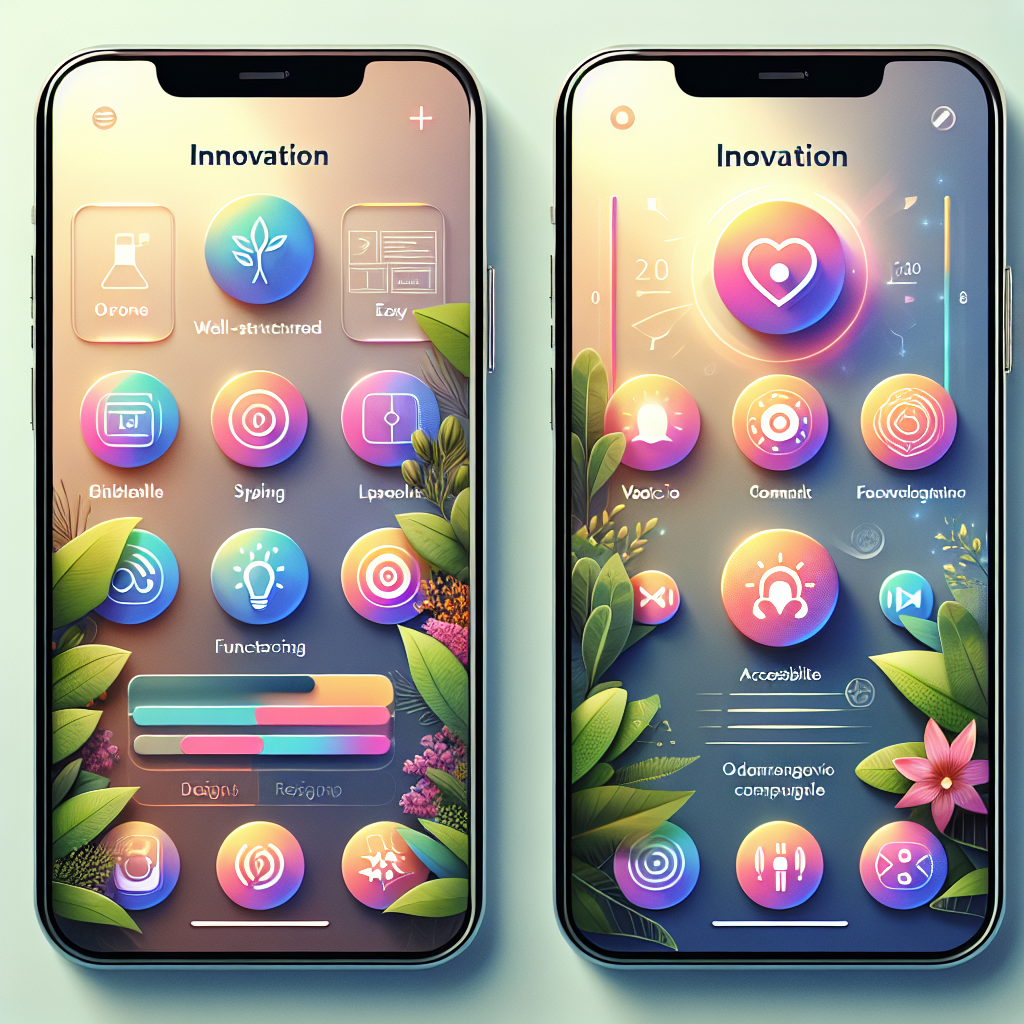In today’s digital landscape, *user experience (UX)* has become a critical factor for the success of mobile applications. Understanding how to improve user experience on mobile apps requires a deep dive into the various elements that contribute to an app’s usability and satisfaction. A well-designed user experience can lead to increased user retention, higher engagement rates, and a greater likelihood of app recommendations.
To truly grasp the essence of user experience, one must consider several key aspects:
- Usability: This refers to how intuitive and easy it is for users to navigate your app. A seamless interface that allows users to find what they need effortlessly is paramount.
- Accessibility: Ensuring your app is usable for people with different abilities is essential. Consider implementing features like voice commands or screen readers.
- Performance: Users expect apps to load quickly and perform efficiently. Slow apps can lead to frustration and abandonment.
- Visual Design: Aesthetics matter; a visually appealing app can enhance user satisfaction. Use consistent colors, fonts, and layouts that align with your brand.
- User Feedback: Regularly soliciting and integrating user feedback helps identify pain points and areas for improvement.
By focusing on these elements, developers can create mobile applications that not only meet user expectations but exceed them. If you’re looking for expert guidance on how to enhance your app’s user experience, Book A Consultation Now!
Key Elements to Enhance User Experience

Enhancing user experience in mobile apps involves a combination of several *key elements* that work together to create an engaging and satisfying user journey. By focusing on these elements, app developers can significantly improve how users interact with their applications.
Here are some crucial components to consider:
- Intuitive Navigation: Users should be able to navigate your app with ease. Clear menus, easily accessible buttons, and a logical flow can help users find what they need without frustration.
- Responsive Design: A responsive design ensures that your app looks and functions well on various devices and screen sizes. This adaptability is crucial in today’s multi-device environment.
- Fast Load Times: Users are likely to abandon an app that takes too long to load. Optimizing images, reducing the number of HTTP requests, and utilizing caching can enhance performance.
- Consistent Branding: Maintaining a consistent brand identity throughout the app creates a cohesive experience. This includes color schemes, typography, and logo placement.
- Onboarding Experience: A well-designed onboarding process introduces new users to your app’s features and functionalities, helping them understand how to use it effectively.
- User-Centric Features: Incorporate features that are relevant and beneficial to your target audience. Customization options, notifications, and social sharing can enhance user engagement.
By integrating these critical elements into your mobile app, you can create a more enjoyable experience for your users, leading to increased satisfaction and loyalty.
Best Practices for Mobile App Design
Adopting best practices in mobile app design is essential for creating an app that not only looks good but also functions seamlessly. These practices help ensure that users have a positive experience, fostering engagement and retention.
Here are some best practices to consider:
- Simplicity: Aim for a clean and straightforward design. Avoid cluttering the interface with too many elements. A simple layout allows users to focus on the key functionalities of the app.
- Visual Hierarchy: Establish a visual hierarchy by using size, color, and placement to guide users’ attention to the most important elements. This can enhance usability and make navigation more intuitive.
- Touch-Friendly Interfaces: Design your app with touch interactions in mind. Buttons and clickable elements should be large enough for users to tap easily, reducing frustration and errors.
- Color Contrast: Ensure that there is sufficient contrast between text and background colors. This improves readability and accessibility for all users, including those with visual impairments.
- Feedback Mechanisms: Incorporate visual or auditory feedback for user actions. For example, buttons should change color when pressed, and notifications can alert users of successful submissions or errors.
- Testing and Iteration: Regularly testing your app with real users provides valuable insights into usability. Use their feedback to iterate and improve the design continuously.
By following these best practices, app developers can create a user-friendly design that enhances the overall experience, making your mobile app a joy to use.
Importance of Usability Testing for Apps

Usability testing is a critical aspect of mobile app development that directly impacts user experience. It involves observing real users as they interact with your app, providing insights into how intuitive and effective the design is. Understanding the importance of usability testing can lead to significant improvements in your app.
Here are several reasons why usability testing is essential:
- Identifies User Pain Points: Usability testing uncovers specific areas where users struggle, allowing developers to address these issues before launch. Identifying these pain points early can save time and resources in the long run.
- Enhances User Satisfaction: By focusing on real user feedback, developers can tailor the app to meet user needs and preferences. This leads to higher satisfaction rates and encourages user retention.
- Informs Design Decisions: Data gathered from usability testing provides concrete evidence to guide design choices. This ensures that decisions are based on actual user behavior rather than assumptions.
- Improves Accessibility: Testing with diverse users, including those with disabilities, helps ensure that your app is accessible to everyone. This not only broadens your audience but also complies with legal standards for accessibility.
- Reduces Costs: Addressing usability issues during the testing phase is significantly cheaper than making changes post-launch. Early identification of problems can minimize the need for extensive app revisions later on.
Incorporating usability testing into your app development process is crucial for creating a successful mobile application that resonates with users. By prioritizing usability, you enhance the overall experience and increase the likelihood of your app’s success in a competitive market.
Leveraging User Feedback for Improvements

In the ever-evolving landscape of mobile applications, leveraging user feedback is essential for continuous improvement and sustained user engagement. By actively seeking and analyzing feedback, developers can make informed decisions that enhance the overall user experience.
Here are key strategies to effectively leverage user feedback for app improvements:
- Establish Feedback Channels: Create multiple avenues for users to provide feedback, such as in-app surveys, email, and social media platforms. This approach ensures that users feel their opinions are valued and encourages more responses.
- Analyze User Reviews: Regularly monitor app store reviews and ratings. These reviews often highlight both strengths and weaknesses, offering a wealth of information about user preferences and pain points.
- Conduct User Interviews: Engage directly with users through interviews or focus groups. This qualitative feedback provides deeper insights into user behaviors, motivations, and specific areas for improvement.
- Implement Feedback Loops: Keep users informed about the changes made based on their feedback. This transparency fosters a sense of community and loyalty, as users see their suggestions being acted upon.
- Prioritize Feedback: Not all feedback is equally important. Use analytics to determine which issues affect the most users. Prioritize improvements that will have the greatest impact on the overall user experience.
By systematically incorporating user feedback into the development process, app creators can ensure that they remain aligned with user needs and expectations. This proactive approach not only enhances the app’s functionality but also builds strong relationships with users, ultimately leading to greater satisfaction and loyalty.
Strategies for Continuous User Engagement

Maintaining user engagement is critical for the success of any mobile application. Implementing effective strategies for continuous user engagement can lead to higher retention rates and foster a loyal user base. Here are some actionable strategies:
- Push Notifications: Utilize push notifications to remind users about app features, updates, or special promotions. Ensure that these messages are personalized and relevant to avoid overwhelming users.
- In-App Rewards: Introduce a rewards system that incentivizes users to interact with your app regularly. This could include points for completing tasks, exclusive content, or discounts on services.
- Regular Updates: Keep the app fresh with regular updates that introduce new features, improvements, or seasonal content. This not only enhances functionality but also gives users a reason to return.
- Engaging Content: Provide valuable content tailored to your users’ interests. Whether it’s articles, videos, or interactive features, engaging content keeps users coming back for more.
- Community Building: Foster a sense of community within your app. This can be achieved through forums, social sharing features, or user-generated content, encouraging users to interact not just with the app but also with each other.
By focusing on these strategies, app developers can create an engaging environment that encourages users to return frequently. It’s not just about attracting users; it’s about keeping them invested in your app’s journey. Ready to enhance your app’s user engagement strategy? Book A Consultation Now!
